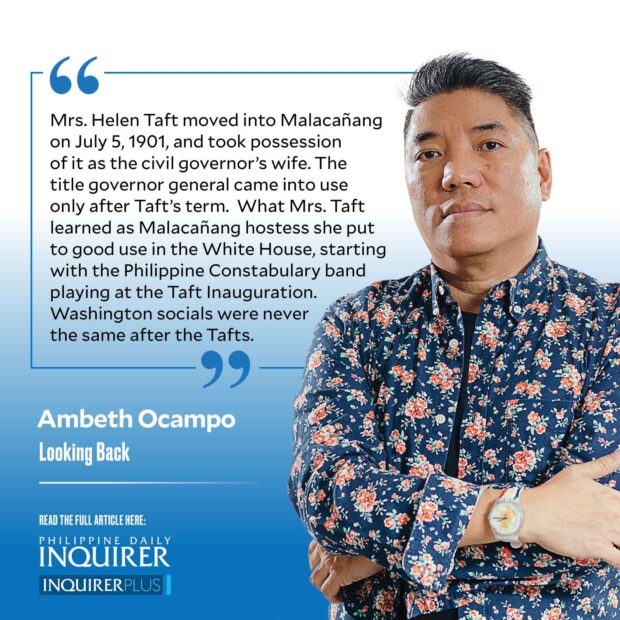From Malacañang to the White House
 I have been looking at Philippine photographs in the Bentley Historical Library at the University of Michigan in Ann Arbor for some weeks now. I came across many photographs of William Howard Taft (1857-1930), the only person who has occupied both Malacañang (as the first civil governor of the Philippines) and the White House (as the 27th president of the United States). He was tall, obese, and might have made good money playing Santa Claus if he didn’t serve in the US government, first in the executive department, and later in the judiciary as the 10th chief justice of the US Supreme Court.
I have been looking at Philippine photographs in the Bentley Historical Library at the University of Michigan in Ann Arbor for some weeks now. I came across many photographs of William Howard Taft (1857-1930), the only person who has occupied both Malacañang (as the first civil governor of the Philippines) and the White House (as the 27th president of the United States). He was tall, obese, and might have made good money playing Santa Claus if he didn’t serve in the US government, first in the executive department, and later in the judiciary as the 10th chief justice of the US Supreme Court.
One Taft photograph caught my eye because it had him sitting on the porch of a house, with a handwoven mat or “banig” from Basey, Samar, at his feet. It was personalized with the Spanish form of “To President Taft.” I wouldn’t be surprised if some of his souvenirs from the Philippines also include a personalized Ilocos blanket or the tabletop shingle with his name and position boldly carved into Romblon marble. I served over nine years in government and am proud to say I never had these Romblon name plates on my desk simply because they reminded me of “lapida” or gravestones.
While Mr. Taft dominates the Philippine materials I have been browsing, I wish there was more material on Mrs. Taft or Helen Herron Taft (1861-1943), the first US first lady to publish a memoir, “Recollections of Full Years” (1914). Eight of the 19 chapters of the memoir are on the Philippines. Some interesting photos in the book are of Mrs. Taft in a terno and the elaborate four-poster bed in red narra, custom-made, for the 300-pound Mr. Taft. While she was an accomplished hostess, Mrs. Taft had her baptism of fire when she returned from a trip to Baguio and found out that her husband had invited 2,000 people to a party at their home in Malate. To accommodate all the guests, more Filipinos than Americans, she organized a garden party with Japanese lanterns hanging on the trees and a refreshment tent sent up. She didn’t send eggs to Santa Clara for good weather, and her well-planned party was rained out.
Mrs. Taft moved into Malacañang on July 5, 1901, and took possession of it as the civil governor’s wife. The title governor general came into use only after Taft’s term. She reminisced:
“Malacañang is old and rather damp and, in my time, some of it had not been furnished or finished according to modern ideas, but in size and dignity it leaves nothing to be desired, and it has historic associations which give it an atmosphere that I found to be quite thrilling. It contains many fine, old-world Spanish portraits, and there is one large canvas of especial interest which hangs at the head of the main stairway. It depicts the ceremony through which Magellan made peace with the natives of Cebu when he landed on that island in April 1521. This consisted of drawing blood from the breasts of the principal parties to the contract, the one drinking that of the other. The Spaniards called it the Pacto de Sangre, or the Blood [Com]Pact, and so the picture is named.”
Actually, this is Juan Luna’s painting depicting Miguel Lopez de Legaspi and Sikatuna doing the sandugo that still hangs by the main staircase of Malacañang.
She also noted that: “Frequently during bad typhoons, I have seen water two and three feet deep in the entrance hall, but it always receded very rapidly and seldom gave us any inconvenience.” The staff consisted of an eccentric Chinese cook and six “muchachos” who polished the hardwood floors using banana leaves on their feet. The Spanish-style furniture she found there was covered in black paint making it “depressingly sombre to me.”
But there were memorable moments on the Malacañang verandah facing the Pasig River: “I began to love the tropical nights and to feel that I never before had known what nights can be like. The stars were so large and hung so low that they looked almost like raised silver figures on a dark blue field … The wonderful sunsets and the moonlit night have tied more American hearts to Manila and the Philippines than all the country’s other charms combined. And they are both indescribable.”
What Mrs. Taft learned as Malacañang hostess she put to good use in the White House, starting with the Philippine Constabulary band playing at the Taft Inauguration. Washington socials were never the same after the Tafts.
Comments are welcome at aocampo@ateneo.edu




















